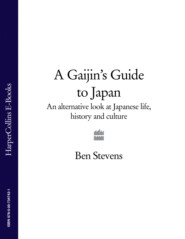
Полная версия:
A Gaijin's Guide to Japan: An alternative look at Japanese life, history and culture

A GAIJIN’S GUIDE TO JAPAN
An alternative look at Japanese life, history and culture
Ben Stevens

Copyright
The Friday Project
An imprint of HarperCollins Publishers Ltd.
1 London Bridge Street
London SE1 9GF
www.harpercollins.co.uk
First published by The Friday Project in 2009
Ben Stevens asserts the moral right to be identified as the author of this work
A catalogue record for this book is available from the British Library
All rights reserved. No part of this publication may be reproduced, stored in a retrieval system, or transmitted, in any form or by any means, electronic, mechanical, photocopying, recording or otherwise, without the prior written permission of the publishers
HarperCollinsPublishers has made every reasonable effort to ensure that any picture content and written content in this ebook has been included or removed in accordance with the contractual and technological constrains in operation at the time of publication
Source ISBN: 9781906321215
Ebook Edition © OCTOBER 2009 ISBN: 9780007347421
Version: 2016-09-22
for Kazuyo
Table of Contents
Cover Page
Title Page
Copyright
Dedication
Introduction
A
B
C
D
E
F
G
H
I
J
K
M
N
O
P
R
S
T
U
V
W
X
Y
Z
Keep Reading
Other Books By
About the Publisher
INTRODUCTION
In 1853, a Reverend Samuel Wells Williams—in Japan to act as translator to Commodore Matthew Perry (See Black Ships, The)—declared the Land of the Rising Sun to be ‘…the most lewd of all the heathen nations I have seen’.
As it transpired, however, the good Reverend was a bit of a dork who couldn’t even speak Japanese all that well, so we shouldn’t take his opinion too seriously. He was merely distressed that women laboured bare-breasted in the paddy fields—a fact which, if he’d lightened up a little, may well have actually put a smile on the miserable old coot’s face.
Since then, a host of academics and other experts on Japanese history, language, culture and customs have pondered such important questions as: Why did nearly every Japanese woman under the age of thirty go nuts over David Beckham during and after the 2002 World Cup? Why will saying ‘Chin-chin!’ at a Japanese drinking party result only in stony stares and an awkward silence? And is it really true that many samurai warriors liked—in their spare time—to get ‘down and dirty’ with one another?
Here, finally, are explanations concerning these and many other weighty matters. (Around 200 of them, in fact.) I have compiled this book while residing in Japan, teaching English for a living (surprise, surprise), immersing myself in judo and karate training (the origami course was full) and occasionally indulging in the mystical, ancient art of karaoke.
In A Gaijin’s Guide…, I set out to record everything that struck me as being relevant to this fascinating country. You hold the end result in your hands. Hopefully it will entertain, enlighten and otherwise delight you. Now, hajimashou—let’s begin…
A
ABE, SADA
I can pretty much guarantee that any male reading this is shortly going to be crossing his legs and wincing…You ready? Okay—born in 1905 to a respectable family of tatami makers, Sada Abe became a rebellious teenager whom her parents, in despair, sold to a geisha house. Unwilling to undertake the years of rigorous training necessary to become a geisha, however, Abe became a prostitute instead.
She seems to have had an insatiable appetite for sex, indulging in a string of lovers, as well as paying customers. However her physical desire came at a cost: on several occasions throughout her life, she would require treatment for syphilis.
It was when Abe quit prostitution to become a waitress that she met the man whom she thought would become the love of her life. Kichizo Ishida was the (married) owner of the Yoshidaya restaurant in Tokyo where Abe worked, and the pair were soon embroiled in an affair. His sexual stamina left even Abe reeling; on occasion the pair remained in bed for anything up to four days, with Ishida sometimes demanding that a shamisen player perform for them as they made love.
When Ishida rejected her for a time and returned to his wife, Abe was devastated. They briefly resumed their affair—this time experimenting with ‘erotic’ asphyxiation (they tightened an obi or ‘belt’ around each other’s neck at the moment of climax)—but Abe was paranoid that Ishida would leave her again.
Early on the morning of May 18, 1936, Abe strangled Ishida to death (using their treasured obi) as he slept. Then, using a knife, she hacked off his penis and testicles before depositing them—wrapped in newspaper—in her handbag. (Kind of makes the old bunny-boiling routine all seem a bit tame, really.) Using the blood to write ‘Sada and Kitchi together’ on the bedsheets, Abe then went on the run, managing to evade the police for three days before being captured (by which time the ‘Abe Sada Incident’ had successfully scandalized the whole of Japan). She told the police: ‘…I knew if I killed him, no woman would ever touch him again.’
At the resulting trial—and contrary to her own wishes, as well as those of the prosecution—Abe was not given the death penalty. She instead received a mere six years for the murder of her lover and the subsequent mutilation of his corpse. (The luckless Ishida’s genitalia, meanwhile, were put on public display for a time at Tokyo University’s Medical School. Nothing like letting the poor sod rest in peace, was there’)
Ultimately, Abe served only five years’ imprisonment, being released in May 1941. She attempted to resume her life under an alias, and again had a succession of lovers—but each time the relationship ended when her real identity inevitably became known. (Can’t think why…) In the end, Abe accepted a curious form of employment, being paid to appear at a succession of inns, to cause the male patrons to experience a pleasurable frisson of fear as she stared haughtily at them.
Later in her life, Abe largely disappeared from public view, and it’s not known exactly when she died. But it’s believed to have been some time around 1987, when Abe would have been aged approximately eighty-two—for only then did she finally stop putting flowers on Kichizo Ishida’s haka (tomb).
The ‘Abe Sada Incident’ was the inspiration for the sexually explicit (of course) 1976 movie, In the Realm of the Senses.
AINU
Comparisons between the Ainu and the native Indians of North America abound, although the Japanese wouldn’t thank you for saying so. According to Ainu legend, they were in Japan ‘100 000 years before the Children of the Sun’—but as soon those 100 000 years were up, they began losing territory to the Japanese pretty darn steadily.
The Ainu resided mainly to the north of the country, particularly on the island of Hokkaido, which would eventually become their final place of refuge. Their story is depressingly familiar the world over: bullied and hounded from anywhere the Japanese wanted for themselves; forced to agree to unfair land-share deals that were then broken anyway, and brutally dealt with on the few occasions when they tried—always unsuccessfully—to meet force with force.
For a while, the Ainu were left in relative peace in Hokkaido, although following the Meiji Restoration the large and sparsely populated island began to be viewed as the perfect solution to what, in the rest of Japan, was fast becoming an overcrowding problem.
More and more Japanese began to move to Hokkaido. In case they should be disturbed by the indigenous population—who if they were male didn’t shave once they’d entered adulthood, and who if they were female commonly had a variety of facial and body tattoos—the Meiji ‘government’ (in truth more like an oligarchy) outlawed the Ainu language and many of their customs, while forcing them to live on state-owned ‘farming plots’.
Today, an estimated 150 000 Ainu remain, although many choose to keep their identity a secret due to the discrimination they continue to suffer. Their language is also threatened with extinction: there are well under 1 000 native speakers left.
AKACHOCHIN
The closest thing Japan has to a Western-style public house, the akachochin is readily identifiable by the large red lanterns hanging outside. (Akachochin literally means ‘red lantern’—in days gone by these signified that somewhere sold alcohol.)
Just open the sliding door and venture inside, and if you can’t make head nor tail of the food menu that’s usually written entirely in Japanese, it probably doesn’t matter. There’ll often be at least one customer who speaks sufficient English to help you decipher the à la carte menu, or you can just gesture—with a polite and very Japanese-like movement of the hand—at something you see being eaten that looks quite tasty.
Perhaps you fancy some yakitori (pieces of chicken and onion barbecued on skewers) or maybe you’re willing to try grilled squid. And to go with it—beer or sake? The choice, as they say, is yours.
AKANAME
Commonly used by parents to scare children into cleaning the bath, an akaname (a combination of two words: aka or ‘dead skin’, and name, which comes from the verb nameru—‘to lick’) is a human-cum-frog-like creature with wild hair, an incredibly long tongue and a single clawed toe. It has a penchant for entering dirty bathrooms in the dead of night and licking them clean, which would be very nice of it, if its left-over saliva did not subsequently cause an illness in any human who came into contact with it. And by ‘illness’ I don’t mean a nasty rash or a touch of flu. No, the akaname is frequently credited with causing such serious maladies as pneumonia and cancer. Which is, if you ask me, a bit much, even to scare the most unruly of children into cleaning the bathtub.
Конец ознакомительного фрагмента.
Текст предоставлен ООО «ЛитРес».
Прочитайте эту книгу целиком, купив полную легальную версию на ЛитРес.
Безопасно оплатить книгу можно банковской картой Visa, MasterCard, Maestro, со счета мобильного телефона, с платежного терминала, в салоне МТС или Связной, через PayPal, WebMoney, Яндекс.Деньги, QIWI Кошелек, бонусными картами или другим удобным Вам способом.
Вы ознакомились с фрагментом книги.
Для бесплатного чтения открыта только часть текста.
Приобретайте полный текст книги у нашего партнера:
Полная версия книги
Всего 10 форматов



